
by Sam Lemonick Thursday, June 7, 2018
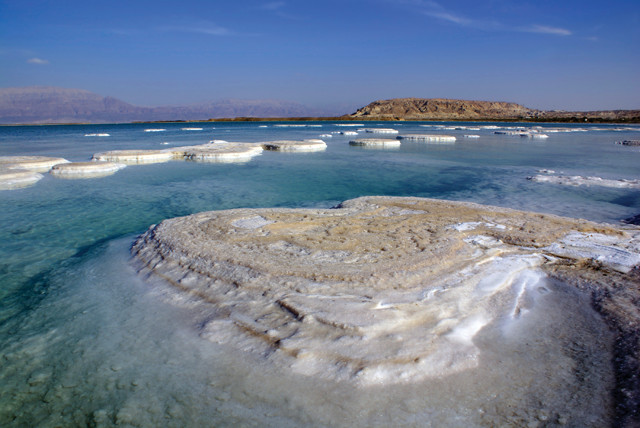
Salt formations rise up from the Dead Sea. Credit: ©iStockphoto.com/Irina Opachevsky
Almost anywhere you turn in Israel, you’re bound to find fascinating geology or the remnants of ancient human history. Some of the best of both can be found where you might least expect it — near the Dead Sea, one of the least hospitable places on Earth. Located in the western Judean Desert on the border between Israel and Jordan, the sea is an artifact of incredible tectonic activity, which also birthed the jagged mountains that surround one of the world’s saltiest bodies of water.
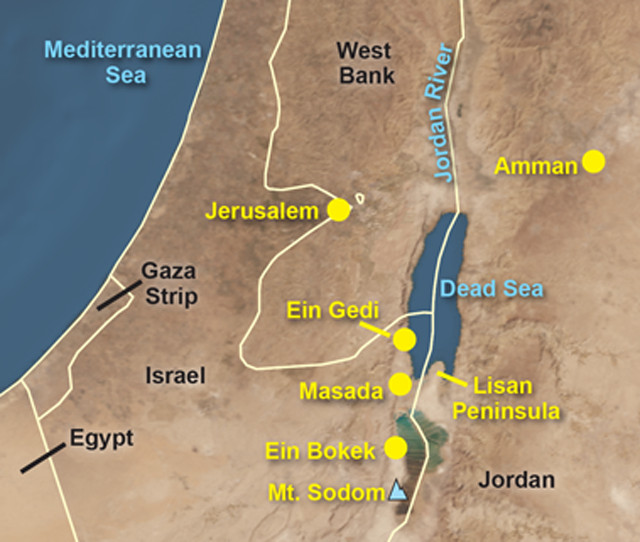
Credit: AGI/NASA
Life has not shunned the area completely, however. Green oases on the sea’s shores support villages that draw in as many as a million tourists a year. Some visitors are looking to take a soak in the Dead Sea’s waters and lather in its thick mud, thought to be good for skin. Others are attracted by nearby canyons carved over millennia by spring rains, offering hikers a taste of the desert. Even the Romans took advantage of the forbidding environment to build an almost-impregnable fortress that visitors can still explore today.
The Dead Sea region’s geology is defined by the Dead Sea graben. A graben, German for “ditch,” is a depression that forms between the faults of two diverging plates, in this case the African and Arabian plates. The African Plate rotates counterclockwise while the Arabian Plate moves roughly northward. As they move apart, faults form in the graben and pieces of crust sink into the mantle. About 3 million years ago, water filled the graben, forming the Dead Sea, which was then part of a long bay of the Mediterranean Sea. A million years later, tectonic activity lifted the land to the west, isolating the Dead Sea from the Mediterranean. As the sea receded from its highest levels, it left behind large salt formations. Two of the largest are the Lisan Peninsula and Mount Sodom, visible along the southern and southwestern shores of the sea, respectively.
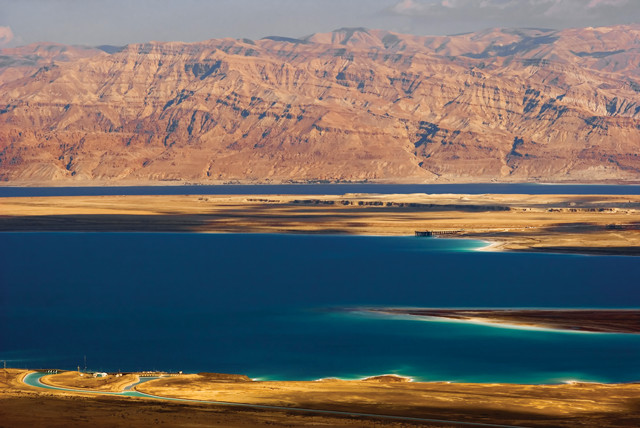
The Dead Sea is one of the saltiest bodies of water in the world. Credit: ©Shutterstock.com/Dejan Gileski
Today, the Dead Sea — Earth’s lowest point on land at more than 400 meters below sea level — is mostly replenished by the Jordan River flowing in from the north and by a few small nearby springs. Nothing flows out. This hydrological scenario helps explain why the Dead Sea is so salty. Because there is no outlet, the minerals that the Jordan River brings in become trapped in the sea. Extremely low rainfall (less than 10 centimeters per year on average) and high evaporation rates in the desert environment compound that effect and give the sea a salt concentration a little higher than 30 percent — making it roughly 10 times saltier than the oceans. This salinity is high enough to kill any fish that accidentally make their way into the Dead Sea, but the name is technically a misnomer: Algae and some salt-loving bacteria are known to thrive here.
Throughout history, the water levels in the Dead Sea have experienced a number of dramatic rises and falls due to seismic activity. But in recent years, human activity has led to a big drop. Increased use of the Jordan River for irrigation and drinking water has caused water levels to fall 22 meters since 1970, and now they continue to drop about one meter each year. The Jordanian government has discussed diverting some water from the Red Sea as a potential fix.
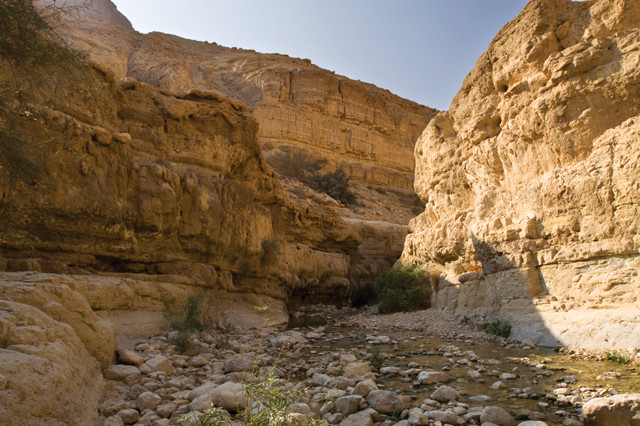
Hiking wadis in the Dead Sea region is a popular activity. But beware: Like slot canyons in the American West, the wadis can fill with water with little notice. Credit: ©iStockphoto.com/bigworld
Visitors looking to take a dip in the Dead Sea from the Israeli side — it is also accessible from Jordan — can access it through the Ein Bokek resort district in the south or the Ein Gedi kibbutz in the north. Both areas have public beaches, hot springs and spas. If you plan to swim in the sea, bring water shoes as the precipitated salt on the seafloor is very sharp. Because of its saltiness, the water can irritate skin, so refrain from shaving the day before visiting. And of course, when swimming, avoid getting water into your eyes; the result is very painful! After taking these precautions, you can enjoy the strange experience of floating with almost half your body above water and the smooth, slippery feeling of the salty water.
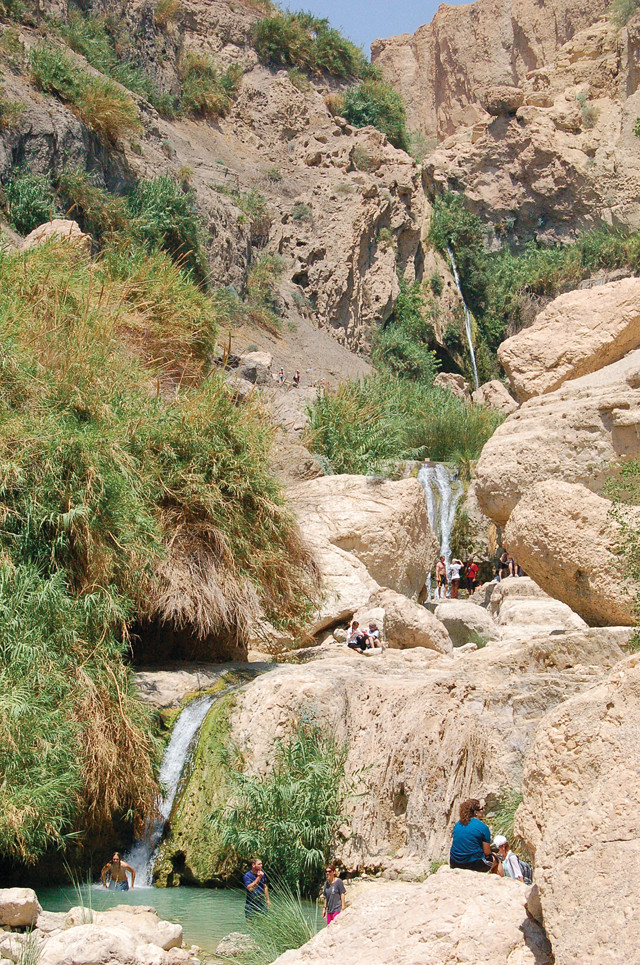
Hikers who trek through the canyons of the Ein Gedi Nature Reserve can take a dip in the park's springs. Credit: ©Synn Wang, Creative Commons Attribution-NonCommercial-ShareAlike 2.0 Generic
The Dead Sea region offers tourists more than just leisurely floats. Hikes through the Ein Gedi Nature Reserve’s wadis — narrow sandstone channels in the surrounding hills filled seasonally by streams — are a good way to experience the area’s geology up close. Springs can be found deep in the wadis, and a swim in the pools that form where the springs emerge is a welcome reward for those who make the hot, dry hikes through the canyons. But be careful of flash floods, especially in winter and spring. Sunny days can be deceptive, as some floods are caused by distant rainstorms, so always check the weather forecast for warnings and check with park rangers. The reserve offers wadi hikes to two popular springs — Nahal David and Nahal Arugot — which begin at the park’s visitor’s center just north of the Ein Gedi kibbutz.
Although the streams and springs are sometimes dangerous to hikers, they are the lifeblood of the region. In 2006, hydrologists from Jerusalem’s Hebrew University mapped an enormous rain-fed aquifer in the limestone and sandstone to the west of the Dead Sea. The group calculated it could contain as much as 2.6 million gallons of water each year. The aquifer feeds several springs, two of which bring water to the Ein Gedi oasis — a lush island of green in the brown foothills east of the sea.
To the south of Ein Gedi is Masada, an ancient fortress and palace built on top of a plateau. The plateau rises 450 meters above the surrounding region, but is only 50 meters above sea level. The stronghold is believed to have been built by the Roman emperor Herod about 35 B.C. as a refuge in case of a revolt. According to an account by the first century A.D. Roman-Jewish historian Josephus, whose works are the only record of Masada’s history, a group of Jewish rebels fighting both the Romans and other Jewish groups captured Masada after fleeing Jerusalem in A.D. 66. A Roman legion then laid siege to the fortress in A.D. 73. After finding the rebels unwilling to surrender, the soldiers constructed an earthen ramp up to the eastern gates of the fortress, where the cliff walls are lowest. Rather than be captured, however, the Jews inside made a suicide pact, and according to legend, killed their wives and children, and then themselves.
The site was rediscovered in 1838, and was surveyed and excavated between 1955 and 1965 by archaeologists led by Yigael Yadin of Hebrew University. In 2001, it was named a UNESCO World Heritage Site. It has been remarkably preserved by the arid climate and its inaccessibility. Masada has deep meaning today for many who see it as a symbol of Jewish resilience and strength, and it is a fascinating and easily explored site for anyone with an interest in archaeology or history. Explanatory placards dot the site, and audio guides are available for those who want more information.
There are three routes to the top of the fortress. A moderately strenuous hour-long hike goes up the western wall of the plateau along the Snake Path, one of the original trails to the fortress. It is well-maintained with handrails and steps in steeper places, and offers beautiful views of the Dead Sea and Jordan on the opposite shore. From the east, visitors only need 20 minutes to easily walk up the siege ramp originally built by the Romans. There is also a cable car to the summit.
When planning a trip to Masada, remember that the desert can be very hot at all times of the year. Many people choose to make the hike at dawn to see the sun rise over the Mountain Heights Plateau in Jordan. Even if you aren’t moved to get up in the dark, it’s a good idea to go early to avoid the heat. The desert warms up quickly, so leave plenty of time to look around the fortress and climb down. Wear a hat and layered clothing that you can remove as the temperature rises. A water bottle is also a necessity and can be refilled from fountains at the summit.
Once at the top, visitors are free to roam the 9-hectare site. You can wander through storerooms and Roman bathhouses still largely intact, see beautifully restored frescoes, and marvel at the incredible water collection and storage system built by Herod’s engineers. The system could trap and hold an estimated 1,050 gallons of rainwater to sustain inhabitants during a siege. The largest building is the Western Palace, which housed royal apartments, administrative offices and workshops. Also on the plateau are the remains of a fifth or sixth century A.D. Byzantine church and a first century B.C. synagogue that is one of the oldest in the world. Looking over the fortress’ outer walls, you can see the footprint of the siege wall the attacking Romans built to encircle the plateau.
Hanging off the northern cliffs is the Northern Palace, consisting of three terraces clinging improbably to the sheer face and overlooking the Ein Gedi oasis. Herod is thought to have stayed in the uppermost terrace and reserved the lower two for entertainment and relaxation. Bright frescoes and the remains of Roman columns can be seen by those willing to brave a little vertigo and climb the steep steps built to access the palace. It was outside the Northern Palace that archaeologists found 11 small ostraca, pieces of stone or pottery often used as voting ballots, which some believe the last Jewish rebels used to cast lots to decide who would take his own life after killing his 10 remaining comrades.
The Dead Sea is one of the few places on Earth where you can so easily see so much evidence of ancient civilizations and even older geological processes. Those fortunate enough to marvel at the timeless wonder of the place will appreciate why Israel has attracted so many people for so long.
© 2008-2021. All rights reserved. Any copying, redistribution or retransmission of any of the contents of this service without the expressed written permission of the American Geosciences Institute is expressly prohibited. Click here for all copyright requests.